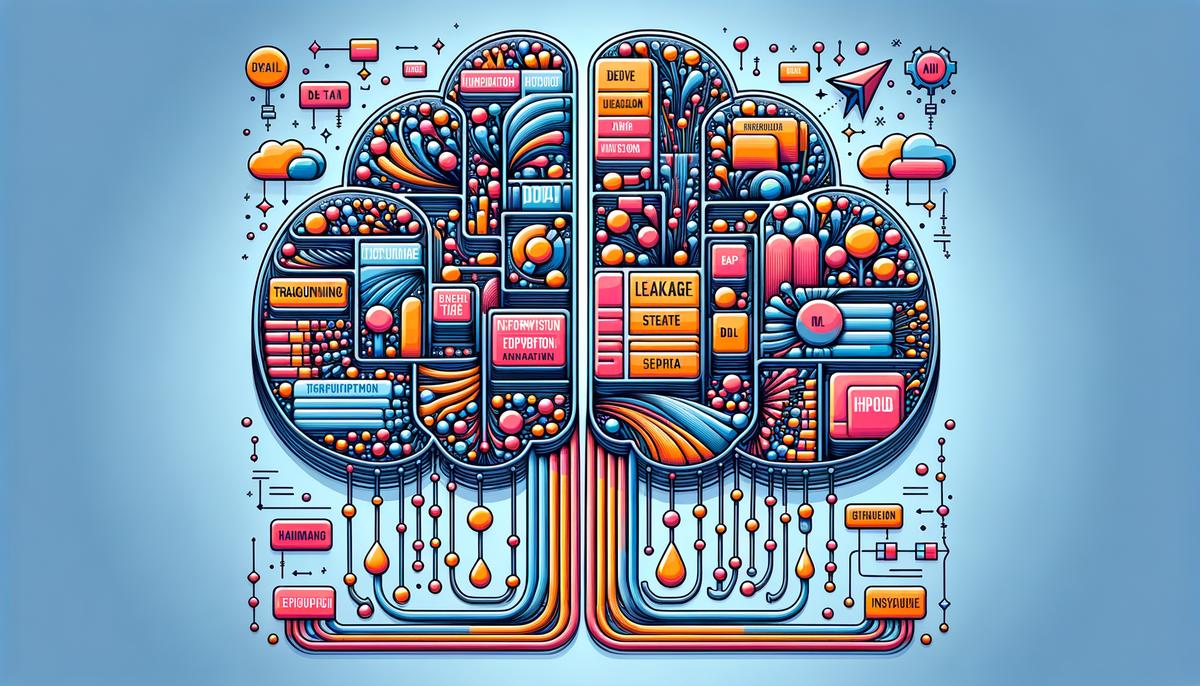Data leakage in machine learning is a subtle yet significant issue that can distort the performance of models, leading to overly optimistic results that do not hold up in real-world applications. This topic, while technical, touches on the foundational aspects of building reliable predictive models. As we venture into the discussion, we aim to shed light on the various forms data leakage can take and the strategies to mitigate its impact, ensuring that the insights gained are grounded in reality and applicable across diverse scenarios.
Contents
Definition and Overview of Data Leakage
Data leakage in machine learning happens when the data used to train an algorithm accidentally contains information from beyond its training dataset. This occurrence can cause the model to appear more accurate than it truly is, creating a misleading picture of its performance. Essentially, the model gets sneak peeks into the test data or real-world scenarios, cheating its way to higher scores without genuinely learning the needed patterns.
This problem arises in several ways, for example, through inappropriate preprocessing of data, where information from the test set gets mixed into the training set. Imagine you’re trying to predict tomorrow’s weather based only on historical data, but you accidentally include tomorrow’s temperature in your training data. Your prediction model would then wrongly anticipate tomorrow’s weather with uncanny accuracy because it ‘knows’ the answer ahead of time.
Another common way leakage happens is when models are allowed to use data that will not be available at prediction time. For instance, using future data to predict past events—a scenario akin to putting the cart before the horse.
Moreover, leakage can result from target leakage, where features indirectly give away the answer. Suppose you’re diagnosing if someone has a disease and include ‘medication prescribed’ as a feature; the medication becomes a giveaway that the condition was present, skewing your model’s learning process.
Data leakage profoundly impacts a model’s ability to perform in real-world situations. A model that seemed to perform well in the laboratory may flounder when deployed, failing to generalize to new data because it never truly learned the underlying patterns, just the shortcuts.
Preventing data leakage requires careful splitting of training and test data, ensuring that preprocessing steps do not contaminate the training dataset with information from the test set, and being vigilant about the data features selected for model training. Ensuring that models are trained on genuinely predictive features and not on features that inadvertently give away the answer is crucial for creating robust machine learning models.

Types of Data Leakage
Pre-processing Leakage Through Normalization and Feature Selection
When you’re getting your data ready before feeding it into a machine learning model, things can get tricky. Take normalization for instance. It’s like giving your data a uniform size and shape so it fits neatly into the model. But if you normalize your entire dataset all at once, including both training and test data, you’re letting the model sneak a peek at the test data ahead of time. This is because the normalization parameters from the test data seep into the training process, making the model too familiar with the test set.
Feature selection can also spring a leak in a similar way. It’s all about picking which parts of your data are important for making predictions. However, if you select features based on the entire dataset and not just the training portion, you’re basically telling your model, “Hey, look out for these signs because they’ll be on the test.” This unintentional tip-off means the model might perform unnaturally well on the test data, not because it’s smart, but because it’s been given the answers beforehand.
Leakage Through Model Feedback
Imagine teaching a student by letting them correct their mistakes immediately after every single question. They might end up ace-ing the practice test not because they’ve mastered the subject but because they’ve learned the specific answers to the practice questions. This scenario mirrors what happens when a machine learning model learns from its own predictions in a way that makes it cyclical.
If you have a system where model predictions are somehow fed back into the training data, this recycling of data can lead to the model becoming overconfident in its predictions. It’s like the model is cheating off its own paper. Over time, the model tunes itself to these reoccurring patterns, potentially missing out on broader, more general patterns it has not yet seen or learned effectively.
Examples That Bring This to Life
Consider an online recommendation system that suggests new movies based on past ratings. If the system only recommends movies similar to those already rated highly by the user and then uses those same ratings to train the model further, it enters a loop. It will keep recommending the same type of movies, narrowing its understanding of the user’s preferences.
Another example can be found in financial forecasting models. Here, data leakage might occur if today’s stock prices are used to predict yesterday’s market movements by incorporating them into the model indirectly through features derived from the current prices. This is equivalent to having tomorrow’s newspaper today – it creates an unrealistic scenario where the model’s forecasts are artificially inflated.
Overall, both pre-processing-related leakage and feedback-induced leakage highlight how subtle slips in the handling of data can undermine the real-world effectiveness of machine learning models. Tackling these issues requires vigilance in keeping training and testing environments separate, maintaining a clear boundary between data preparation stages, and ensuring that a model’s improvements are driven by genuine learning rather than artificial advantages.

Identifying Data Leakage
Cross-validation stands as a powerful tool to unearth data leakage in machine learning projects. By dividing the dataset into multiple parts, and iteratively using separate parts for training and validation, anomalies in performance metrics can clearly indicate unusual patterns hinting at data leakage. If a model performs exceptionally well on validation data but poorly on unseen data, it’s a red flag signaling potential data leakage.
Utilizing data visualization techniques can also shed light on hidden data leakage. Scatter plots, heat maps, and histograms enable a visual inspection of the relationships between features and between features and targets. An unusually perfect correlation visible in these visual aids might be an indicator that leakage is skewing the data’s natural association.
The drying of pipelines during the development phase could help smoothen the path ahead by pinpointing leakage. Automated tools and scripts that meticulously scan for correlations not justified by the domain knowledge or that track how data flows through the different stages of the project can catch slips that lead to leakage.
Intrigued by abnormal ease of predictions, it might be a hint at underlying leakage. Examples include possessing a validation accuracy that far surpasses benchmarks or expected performance levels without a solid explanation. Such signs necessitate a backtrack to audit the data processing and handling steps, ensuring no unintentional information transfer from the future into the training set.
Overfitting, though a broader issue, can sometimes signal underlying data leakage, especially when conventional methods for mitigating overfitting don’t improve model generalization. This persistence of overfitting despite efforts could suggest that the model has ‘seen’ the test information beforehand or is benefiting from leaky data.
Monitoring feature importance rankings provided by machine learning algorithms can also uncover potential leaks. Features that don’t logically align with domain knowledge yet rank high in influencing model decisions may have received information from the target variable unintentionally.
Encouraging skepticism in early stages of model evaluation encourages a healthy scrutiny of the results. Much like double-checking one’s own work, assuming a position of skepticism towards results that seem too good is a proactive way to snuff out the subtle scent of data leakage.
Lastly, peer reviews and code audits by fellow data scientists can act as a critical checkpoint. Fresh eyes can often catch overlooked gaps or assumptions that lead to data leakage, emphasizing the importance of collaboration in safeguarding against these issues.
Alright, this journey through spotting and understanding different contours of data leakage illuminates pathways not only to identify but to rigorously challenge machine learning models, ensuring their integrity and robustness against the sneaky pitfalls of data leakage.

Preventing Data Leakage
To further shield machine learning projects from data leakage, adopt a layered defense strategy beginning with rigorous access controls. Establish clear role-based access to datasets, ensuring that only authorized personnel have the ability to modify or view sensitive data. This minimizes the risk of accidental leaks by individuals not directly involved in the project.
Enforcing encryption both at rest and in transit adds a robust layer of security. Encrypting data ensures that even if unauthorized access occurs, the information remains undecipherable and useless to intruders. Utilize advanced encryption protocols and keep cryptographic keys secure to enhance data protection.
Pursue an aggressive update and patch management policy for all systems involved in data storage and processing. Outdated software often contains vulnerabilities that can be exploited to gain unauthorized access or leak data inadvertently. Regular updates mitigate these risks and fortify defenses against external attacks.
Incorporate anomaly detection systems to monitor network and system activities continuously. These systems can identify unusual patterns that may indicate a data leak, allowing for swift action to rectify any issues. Anomaly detection leverages machine learning algorithms to distinguish between normal operations and potential security threats, providing an important early warning system.
Implement robust logging and audit trails across all data handling activities. This approach not only aids in identifying the source of a leak after the fact but also deters malicious actions by those aware their activities are being monitored. Audit trails should be comprehensive, covering access records, modification logs, and data export activities.
Opt for a principle of least privilege (PoLP) when designing systems and assigning user access. By restricting access rights for users to the bare minimum necessary for their job functions, the opportunity for data leak, whether intentional or accidental, significantly decreases. Regularly review access privileges as roles change over time to maintain a tight grip on potential data exposure points.
Engaging in regular training sessions for all team members about the importance of data privacy and the common tactics employed by adversaries helps to create a knowledgeable front line of defense. Education should focus on phishing, social engineering, and proper data handling procedures to cultivate a security-aware culture.
Finally, consider third-party audits or certification processes to thoroughly evaluate your data handling and security measures against industry standards. External evaluations can offer new insights and validate the effectiveness of existing data protection strategies, providing assurance that data leakage is being comprehensively addressed.
By weaving these strategies into the fabric of machine learning project protocols, teams not only enhance their defense against data leakage but also reinforce the overall integrity and reliability of their data-driven initiatives.

Case Studies of Data Leakage
In the healthcare industry, machine learning models are crucial for predicting diseases, but even here, data leakage poses serious challenges. For instance, if patient records used to train a disease prediction model include notes entered by doctors after a diagnosis is made, this could lead to an algorithm that seems to predict diseases with unnatural accuracy. However, in reality, the model merely learned to recognize diagnoses already made by physicians, rather than identifying patterns indicative of diseases themselves. This scenario significantly undermines the model’s practical usefulness in actually predicting diseases before clinical diagnoses are made.
Another real-world example involves the creation of fraud detection systems in banking. Banks leverage machine learning to identify potentially fraudulent transactions based on historical data. Yet, a well-known incident occurred where transaction data was inadvertently timestamped with the time when the data was processed for analysis rather than the time when the transactions occurred. As a result, the fraud detection model was inadvertently trained on future data — specifically, subsequent actions taken by the bank in response to transactions, including fraud investigations. This meant that the model was effectively being ‘tipped off’ about which transactions were deemed suspicious, misleadingly boosting its performance metrics during testing but failing to reliably detect fraud in live operation.
In the realm of natural language processing (NLP), data leakage can arise through subtle channels, such as shared text corpora used in both pre-training and fine-tuning stages of model development. For example, in an algorithm designed to summarize texts, if some of the texts in the testing set inadvertently appeared in any form during the training process, the model might not be learning to generalize and summarize effectively but rather remembering and regurgitating specific summaries it saw during training. Such instances emphasize the critical need for rigorous dataset partitioning and validation strategies in NLP tasks to ensure models can genuinely learn and generalize from their training.
Analyzing a failed AI-driven marketing campaign provides further insights into data leakage. A company once designed an algorithm to predict which customers would be most likely to respond to a new product advertisement. Unfortunately, the training data included purchase histories that contained purchases made due to a preliminary market test of the same product. Consequently, the model didn’t learn to identify potential new customers based on independent characteristics but rather ‘cheated’ by flagging those who had already shown interest in the product. This misleadingly inflated its predictive capabilities during testing while proving ineffective in targeting genuinely new customers upon broader deployment.
These case studies underscore data leakage as a pervasive issue across various industries, affecting everything from medical diagnostics to financial security, and emphasize the imperative for strict vigilance in data management practices. Establishing clear data governance protocols and maintaining a vigilant audit trail are paramount in isolating and rectifying instances of data leakage, thereby safeguarding the integrity and efficacy of machine learning applications in real-world scenarios.

In conclusion, the fight against data leakage is an ongoing battle in the field of machine learning, requiring constant vigilance and a proactive approach to data management and model training. The key takeaway is the importance of recognizing and addressing data leakage to prevent the erosion of trust in machine learning models. By adhering to best practices for data handling and model evaluation, we can strive towards creating models that truly understand and generalize from their training, standing robust in the face of new and unseen data.

Emad Morpheus is a tech enthusiast with a unique flair for AI and art. Backed by a Computer Science background, he dove into the captivating world of AI-driven image generation five years ago. Since then, he has been honing his skills and sharing his insights on AI art creation through his blog posts. Outside his tech-art sphere, Emad enjoys photography, hiking, and piano.

